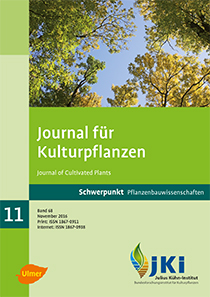Efficacy of different strategies using an ALS-inhibitor herbicide for weed control in sugar beet (<em>Beta vulgaris</em> L.)
DOI:
https://doi.org/10.5073/JfK.2016.11.03Keywords:
Foramsulfuron, thiencarbazone-methyl, application frequency, standardised treatment indexAbstract
In 2013 and 2014, field trials were conducted at six environments in Germany to evaluate the efficacy of a new ALS-inhibiting herbicide containing foramsulfuron and thiencarbazone-methyl (F/T) for weed control in sugar beet cultivation. Five herbicide strategies with different application frequencies of F/T (50 g foramsulfuron ha–1 + 30 g thiencarbazone-methyl ha–1) and a classic herbicide strategy with three applications of phenmedipham (75 g ai ha–1), desmedipham (59 g ai ha–1), ethofumesate (94 g ai ha–1), lenacil (34 g ai ha–1) and metamitron (700 g ai ha–1) were compared. The efficacy of the classic herbicide strategy was between 84 and 99% due to surviving Chenopodium album L., Matricaria recutita L., Mercurialis annua L. and Solanum tuberosum L. Average efficacy of F/T was 95% in the single application treatment. Strategies with two applications combining classic herbicides and F/T achieved an efficacy beyond 97%. This points to an increased flexibility of weed control in sugar beet.
Published
Issue
Section
License
The content of the journal is licensed under the Creative Commons Attribution 4.0 License. Any user is free to share and adapt (remix, transform, build upon) the content as long as the original publication is attributed (authors, title, year, journal, issue, pages).
The copyright of the published work remains with the authors. The authors grant the Journal of Cultivated Plants, the Julius Kühn-Institut and the OpenAgrar repository the non-exclusive right to distribute and exploit the work.







